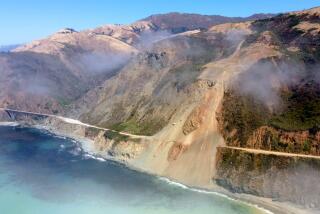Freeway Widening Went Smoothly : Highways: Traffic flowed evenly during two years of improvements on a stretch of the Ventura in Woodland Hills.
- Share via
State Department of Transportation officials ceremonially closed the books Friday on the widening of the Ventura Freeway in Woodland Hills, saying they were pleased that traffic moved smoothly throughout the two-year project despite a more than 10% increase in vehicles.
At a press conference alongside the newly widened freeway, Jerry B. Baxter, Southern California director for Caltrans, attributed the success to widespread use of bypass routes, stepped-up ramp metering and quick response to disabled vehicles by Caltrans-retained tow trucks.
The $23-million project widened the freeway to eight lanes from Valley Circle to Topanga Canyon boulevards and to 10 lanes each way from Wilbur Avenue to Topanga.
The new lanes were created by narrowing existing lanes to 11 feet in width and using part of the median.
Much of the expense was incurred in widening several overpasses and removing and repaving a section of broken pavement near Valley Circle.
Larry Hathaway, Caltrans traffic coordinator for the project, said that during construction more than 1,000 cars an hour used a voluntary eastbound bypass route aimed at diverting motorists headed for Warner Center off the freeway in Calabasas.
Also contributing to moving eastbound traffic along was more restrictive ramp metering at Topanga Canyon Boulevard and Canoga Avenue, downstream from the project, Hathaway said.
In addition, a fleet of tow trucks employed by Caltrans constantly traveled the project during rush hours, removing disabled vehicles in an average of 12 minutes, Hathaway said.
Elsewhere on the freeway system, disabled cars are removed in about 30 minutes, he said.
In the final month of construction, the three eastbound lanes carried 20,000 vehicles each day between 6 and 9 a.m., Hathaway said. One year earlier, the same lanes carried an average of 18,200 vehicles in the morning rush hour, he said.
Caltrans officials attributed the increase to continuing residential growth from Calabasas to Ventura.
Since the new lanes were opened one week ago, there have been no delays other than those caused by accidents or breakdowns, Hathaway said, adding that even in rush hour, “cars are barreling through” an area that had been known for years as the Woodland Hills bottleneck.
Starting in December, Caltrans plans to widen the freeway to 10 lanes from Topanga Canyon Boulevard to Universal City, a project that will also take two years. At present, the freeway varies from eight to 10 lanes, creating a series of bottlenecks.
As with the Woodland Hills project, the next widening phase will be done largely at night, with daytime work screened from motorists.
However, because Victory and Ventura boulevards parallel the 15-mile stretch to be widened, there will be no bypass routes, Baxter said.
More to Read
Sign up for Essential California
The most important California stories and recommendations in your inbox every morning.
You may occasionally receive promotional content from the Los Angeles Times.













